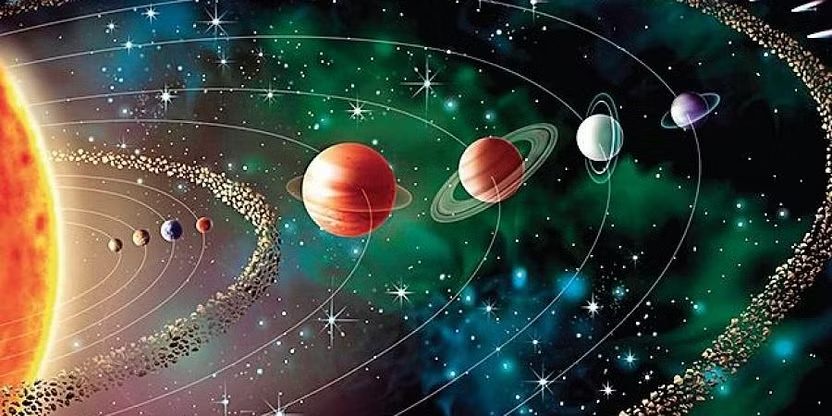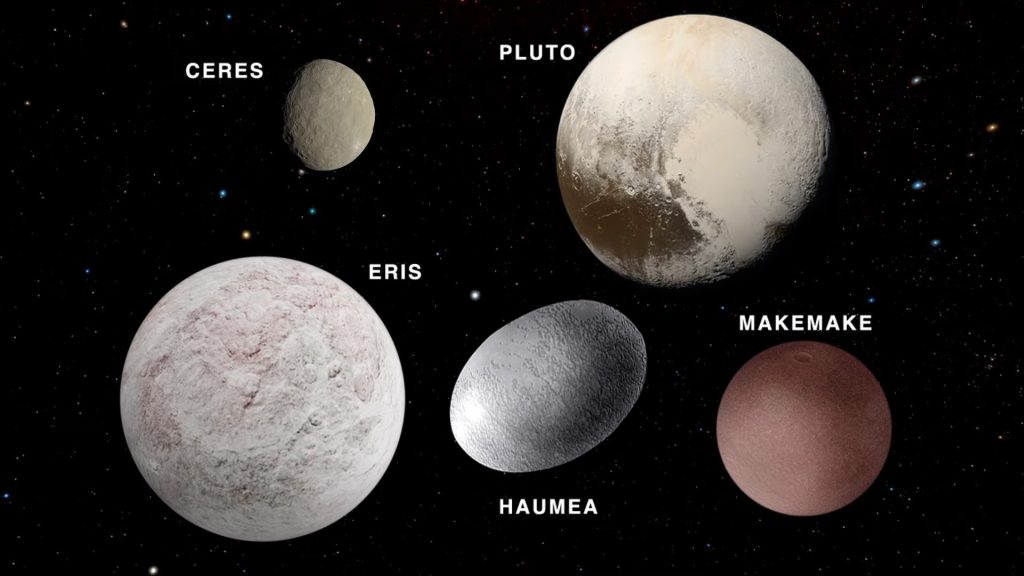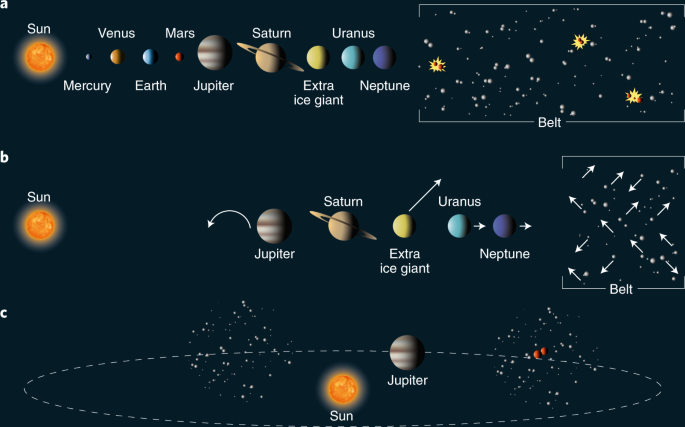What exactly are we seeing when gazing at the cosmos on a clear, dark night? Beyond the glittering stars exist organized systems of planets and other objects gravitationally bound to a central star – these planetary structures are known as solar systems. So, what is a Solar System? Why is the Solar System important?
In this guide, we will unveil the components, forms, and origins of these planetary configurations governed primarily by the gravity of their anchoring stars. Let’s get started!

What Is a Solar System?
Our Solar System consists of the Sun and everything that orbits around it. This includes the eight planets – Mercury, Venus, Earth, Mars, Jupiter, Saturn, Uranus and Neptune – and dwarf planets, moons, asteroids and comets. It lies at the center of our Solar System and makes up 99.8% of the solar system’s mass.
Furthermore, the four inner planets are rocky worlds, while the four outer planets are gas and ice giants. Beyond Neptune is the Kuiper Belt and scattered disc, home to dwarf planets like Pluto. Also, the layout and motions of the solar system’s objects are determined by gravity and inertia as they all orbit the Sun.
Defining Solar System
What is a Solar System definition? A Solar System consists of a star and all the objects that orbit around it due to that star’s gravity. This creates a system where the central star and smaller objects like planets and moons all influence each other through gravitational forces.
What Does a Solar System Consist Of?
Stars
At the heart of every Solar System is a star, often referred to as the Sun. Stars are immense celestial bodies primarily composed of hydrogen and helium undergoing nuclear fusion, producing light and heat. Our Sun, for instance, serves as the gravitational anchor, governing the movements of the surrounding celestial objects.
Planets and dwarf planets
Planets are significant Solar System members revolving around the star. These celestial bodies are diverse in size, composition, and atmosphere. Notably, dwarf planets share similarities with planets but are generally smaller. Earth, Mars, Jupiter, and Saturn exemplify planets, while Pluto is a well-known dwarf planet in our solar system.
Moons, asteroids, comets
Moons, or natural satellites, orbit planets and dwarf planets. These bodies vary in size and play a crucial role in shaping the dynamics of their parent planets.
Asteroids and comets, on the other hand, are smaller celestial bodies that often travel in elliptical orbits. Asteroids are rocky, while comets are icy and develop stunning tails when near the Sun.
Rings, belts, and discs
Some planets and dwarf planets are adorned with spectacular rings or belts encircling them. These features include particles like ice, rocks, or dust, creating mesmerizing patterns. Saturn’s prominent ring system is a prime example.
Some solar systems may also harbor protoplanetary discs. These remnants of the system’s formation contain gas, dust, and potential building blocks for future celestial bodies.
Types of Solar Systems
Single, binary, and multi-star systems
Solar systems come in various arrangements. Like our own, a lone star takes center stage in a single-star system, governing the planetary dance. Binary systems feature two stars orbiting a common center of mass, adding a stellar partner to the cosmic ballet.
Moreover, multi-star systems with three or more stars contribute to a celestial trio or quartet, creating intricate gravitational interactions among the stellar members.
Circumbinary planets
Some planets defy the norm in binary systems by orbiting both stars, known as circumbinary planets. These celestial wanderers navigate the gravitational tango of their dual stellar companions, showcasing the dynamic possibilities within these complex systems. The presence of such planets challenges traditional notions of habitability and orbital stability.
Rogue planets
Not all celestial bodies adhere to the conventional rules of orbit. Rogue planets, untethered by the gravitational influence of any star, roam the interstellar expanse alone.
These nomadic worlds, cast adrift during the chaotic early stages of their solar systems, drift through space, unbound to any stellar partner. Despite lacking a central star, these wandering planets add a touch of cosmic mystery to the diversity of Solar System configurations.
Solar systems come in diverse configurations, from the simplicity of a single-star system to the intricacies of binary and multi-star arrangements. The enigmatic allure of rogue planets adds another layer of fascination beyond our celestial neighborhood.
Each configuration tells a unique tale of gravitational interactions, orbital dynamics, and the cosmic journeys of planets in the vast tapestry of the universe.
Our Solar System
The Sun
The Sun is at the heart of our cosmic neighborhood, a dazzling ball of hot, ionized gasses, predominantly hydrogen and helium. It’s not just a celestial light show; the Sun’s immense gravitational pull governs the entire solar system.
Keeping planets, moons, and other celestial bodies in orbit. The solar energy it radiates sustains life on Earth and sets the rhythm for the dance of the planets.
Terrestrial and Jovian planets
Our Solar System boasts a diverse planetary family. The four inner, rocky planets — Mercury, Venus, Earth, and Mars — form the terrestrial group, characterized by solid surfaces.
Beyond the asteroid belt, we encounter the gas giants Jupiter and Saturn, known as Jovian planets due to their immense size and gaseous compositions. With their fascinating moons and exquisite atmospheres, these colossal objects demand attention.
Dwarf planets, Kuiper Belt, and Scattered disc
While Pluto’s planetary status may have shifted, it remains a noteworthy member of the dwarf planet category, joining others like Eris and Haumea. These diminutive bodies populate the Kuiper Belt, a region beyond Neptune hosting icy remnants from the early solar system.
Further out lies the Scattered disc, an area where eccentric orbits and scattered objects add a touch of celestial chaos. These regions offer a treasure trove of information about our solar system’s formation and evolution.
Our solar system, a cosmic symphony orchestrated by gravitational forces and cosmic histories, invites exploration and admiration. The Sun’s radiant energy nurtures life on Earth.
Meanwhile, the mysteries of distant dwarf planets in the Kuiper Belt contribute to the grandeur of our celestial home. As we continue to unravel the secrets of the solar system, the beauty and complexity of its components continue to captivate our imaginations.

The Dynamics of Orbits
Laws of planetary motion
The graceful rules of planetary motion, outlined by Johannes Kepler, orchestrate the ballet of celestial planets in our Solar System. The first law asserts that planets move in elliptical orbits, with the sun at one of the foci.
The second law states that a planet sweeps equal areas at equal times, emphasizing its variable orbital speed. The third law links a planet’s orbital period to its distance from the sun, providing a cosmic rhythm to its dance.
Rotations, revolutions, and periods
Planets are celestial dancers executing two primary motions – rotation and revolution. Rotation spins a planet on its axis, causing day and night. Revolution, on the other hand, involves the planet’s orbit around the sun.
The time it takes for a planet to complete one full rotation is its rotational period, while the time for one orbit around the sun is the orbital period. These rhythmic movements create the celestial harmony we witness in our daily lives.
Orbital shapes and configurations
Orbits come in diverse shapes, influenced by the balance between gravity and inertia. Circular orbits maintain a consistent distance from the gravitational center, while elliptical orbits exhibit varying distances.
The eccentricity of an orbit quantifies its deviation from a perfect circle. Additionally, some celestial bodies engage in synchronized orbital dances, forming binary systems or resonant configurations. Gravitational interactions shape their paths over time in these intriguing cosmic performances.
So, understanding the dynamics of orbits unveils the intricate interplay between gravitational forces and inertia. It showcases the cosmic choreography that governs the movements of planets, moons, and other celestial entities.
Exoplanetary Systems
Detection methods
Astronomers employ various ingenious methods to detect exoplanets in the quest to explore the cosmic tapestry beyond our solar system. One prevalent technique is the transit method, where astronomers observe a dip in a star’s brightness as an orbiting planet passes in front of it.
The radial velocity method involves detecting the star’s subtle wobble induced by the gravitational pull of an orbiting planet. Cutting-edge technologies like the Kepler Space Telescope and the Transiting Exoplanet Survey Satellite (TESS) have significantly expanded our exoplanet detection capabilities.
Diversity of exoplanets
The exploration of exoplanetary systems has unveiled a staggering diversity of worlds. Like Jupiter and Saturn, gas giants dominate some systems, while others host super-Earths – rocky planets larger than our own.
“Hot Jupiters” orbiting close to their stars and “Ice giants” resembling Uranus and Neptune present intriguing variations. Some exoplanets even orbit two or more stars, reminiscent of Tatooine from Star Wars, adding a touch of science fiction to our cosmic reality.
Earth-like worlds
Finding habitable exoplanets that are Earth-sized and in the habitable zone of their star is an intriguing quest. The habitable zone is the orbital region where conditions could permit liquid water, a key ingredient for life as we know it.
Discoveries like Kepler-442b and Kepler-186f have ignited hope for finding potentially habitable exoplanets. They spark the imagination about the possibility of life beyond our solar system.
The exploration of exoplanetary systems not only broadens our understanding of the vast cosmic landscape but also fuels our curiosity about the potential for life beyond Earth. With ever-evolving technologies and a growing catalog of discoveries, the study of exoplanets continues to unveil the remarkable diversity and mysteries of distant worlds.
Solar System Formation
Nebular theory model
The birth of a Solar System is a cosmic ballet initiated by the Nebular theory. It all begins with a massive cloud of gas and dust called a nebula. Under the influence of gravity, the nebula starts to collapse, and as it contracts, it begins to spin. This sets the stage for the formation of a protostar at the center – the embryonic version of what will become the star of the solar system.
Protoplanetary disc
As the protostar takes shape at the heart of the nebula, the remaining material forms a spinning disc around it. This disc, known as a protoplanetary disc, becomes the cosmic playground for creating planets and other celestial bodies. Within this swirling disc of gas and dust, tiny particles collide and stick together, gradually growing into planetesimals and protoplanets.
Planet migration
The formation of a Solar System isn’t a static process; it involves dynamic movements and migrations. Planet migration occurs as gravitational interactions among planets and the protoplanetary disc influence their orbits.
Some planets may migrate inward toward the star, while others move outward. These planetary migrations play a crucial role in shaping the final arrangement of planets in a solar system.
The intricate dance of the Nebular theory and the emergence of protoplanetary disks tell a fascinating story. The dynamic movements of planet migration add another layer to the narrative of Solar System formation.
From the gravitational collapse of a nebula to the sculpting of planetary orbits, each step in this cosmic narrative contributes to the creation of celestial neighborhoods. We observe these wonders in the vast expanse of the universe.

Conclusion
What is a Solar System? A Solar System comprises a central star and celestial bodies like planets, moons, and asteroids held in orbit by gravity. Physical forces and orbital mechanics dictate the arrangement and motion of these bodies.
We explored the Solar System and highlighted the common components while showcasing their diversity. So, key insights include comprehending the essence of a Solar System and recognizing the Sun as the nucleus of our planetary setup.
Also, planets exhibit diverse features and orbits, and smaller objects like dwarf planets and comets contribute to the complexity of Solar System configurations. However, gaining insight into the intricate systems around stars in our universe will foster a deeper appreciation for astronomy.
